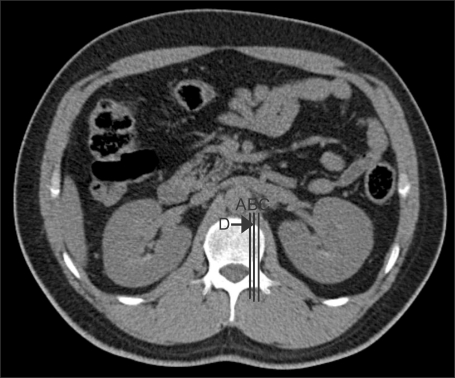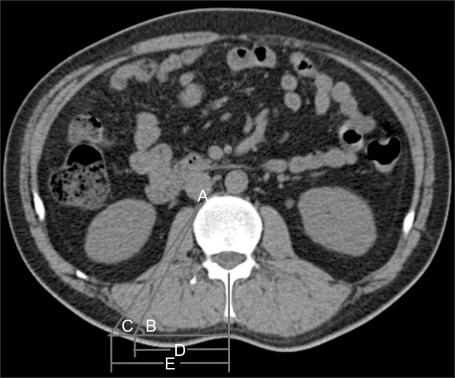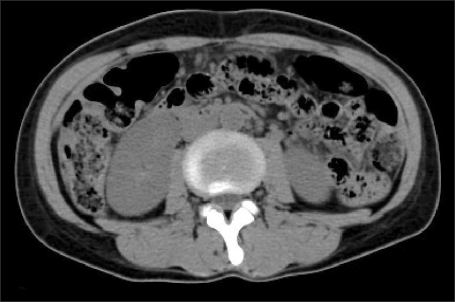Korean J Pain.
2010 Mar;23(1):11-17.
Determination of Adequate Entry Angle of Lumbar Sympathetic Ganglion Block in Korean
- Affiliations
-
- 1Department of Anesthesiology and Pain Medicine, Seoul Medical Center, Sungkyunkwan University School of Medicine, Seoul, Korea.
- 2Department of Anesthesiology and Pain Medicine, Samsung Seoul Hospital, Samsung Medical Center, Sungkyunkwan University School of Medicine, Seoul, Korea. chuljlee@skku.edu
Abstract
- BACKGROUND
The target of lumbar sympathetic ganglion block is the anterolateral surface of the L2, 3 and 4 vertebral bodies, where the lumbar sympathetic ganglion usually lies. In most cases, a block-needle is inserted approximately 5-8 cm lateral to spinous process on the skin and directed to the anterolateral surface of vertebral body obliquely. The purpose of this study is to determine the safe entry angle and entry point in Korean by using the abdominal CT scan images.
METHODS
The abdominal CT images of eighty five patients were recruited to this study. The minimal angle aimed at the lumbar sympathetic ganglion that can pass through the lateral aspect of body and maximal angle that avoids puncturing the kidney, ureter or retroperitoneal space were measured. The distance from midline to skin entry point was also measured.
RESULTS
There was no significant difference in entry angle among L2, 3, and 4 level. The entry angle was similar in the right and left side, and in males and females. The entry angle of old age group was significantly smaller than that of young age group. The calculated safe entry angle was 30.5 +/- 0.4degrees and entry point was 7.7 +/- 0.2 cm and 6.7 +/- 0.1 cm lateral from midline in males and females respectively.
CONCLUSION
These measurements can be used as a reference for lumbar sympathetic ganglion block and radiofrequency lesioning. Prior to performing the lumbar sympathetic ganglion block for cancer patients, the abdominal CT scan should be reviewed to prevent complications.
Figure
Reference
-
1. Boas RA. Sympathetic nerve blocks: in search of a role. Reg Anesth Pain Med. 1998; 23:292–305. PMID: 9613543.2. Stanton-Hicks M. Complications of sympathetic blocks for extremity pain. Tech Reg Anesth Pain Manag. 2007; 11:148–151.
Article3. Niv D, Gofeld M. Raj PP, editor. Lumbar sympathetic blocks. Interventional pain management. 2008. 2nd ed. Philiadelphia: WB Saunders Co;p. 303–321.4. Shim JC. The Korean Pain Society. Nerve blocks in lumbar region. Pain medicine. 2007. 3rd ed. Seoul: Koonja Publishing Inc;p. 643–646.5. Waldman SD. Atlas of interventional pain management. 2004. 2nd ed. Philadelphia: WB Saunders Co;p. 308–312.6. Buckley FP. Loeser JD, Butler SH, Chapman CR, Turk DC, editors. Regional anesthesia with local anesthetics. Bonica's management of pain. 2001. 3rd ed. Philadelphia: Lippincott Wiliams & Wilkins;p. 1935–1938.7. Rocco AG, Palombi D, Raeke D. Anatomy of the lumbar sympathetic chain. Reg Anesth. 1995; 20:13–19. PMID: 7727322.8. Middleton WJ, Chan VWS. Lumbar sympathetic block: A review of complications. Tech Reg Anesth Pain Manag. 1998; 2:137–146.
Article9. Snodgrass JJ. Sex differences and aging of the vertebral column. J Forensic Sci. 2004; 49:458–463. PMID: 15171159.
Article10. Lexell J. Human aging, muscle mass, and fiber type composition. J Gerontol A Biol Sci Med Sci. 1995; 50:11–16. PMID: 7493202.11. Dirim A, Kumsar S. Iatrogenic ureteral injury due to lumbar sympathetic block. Scand J Urol Nephrol. 2008; 42:395–396. PMID: 19230175.
Article12. Kumarov IW, Maclsaac SG, Sioufi J, DeDomenico I. Iatrogenic ureteral injury secondary to lumbar sympathetic ganglion blockade. Urology. 1980; 16:617–619. PMID: 7445314.
Article13. Cutts S, Williams HT, Lee J, Downing R. Ureteric injury as a complication of chemical sympathectomy. Eur J Vasc Endovasc Surg. 2000; 19:212–213. PMID: 10727375.14. Wheatley JK, Montamedi F, Hammonds WD. Page kidney resulting from massive subcapsular hematoma. Complication of lumbar sympathetic nerve block. Urology. 1984; 24:361–363. PMID: 6485196.
Article15. Seo MS, Lee PB, Sim WS, Park SY, Kim YC, Lee SC. A review of insertion site for lumbar sympathetic ganglion block. Korean J Anesthesiol. 2004; 47:698–702.
Article
- Full Text Links
- Actions
-
Cited
- CITED
-
- Close
- Share
- Similar articles
-
- Thoracic Sympathetic Ganglion Block for a Patient with Hyperhidrosis
- Lumbar Sympathetic Ganglion Block with Alcohol for Plantar Hyperhidrosis
- Thoracic Sympathetic Ganglion Block for Two Patients with Thoracic Cancer Pain: A case report
- A Review of Insertion Site for Lumbar Sympathetic Ganglion Block
- Treatment of 43 Patients with Buerger's Disease




